Astonishing Ancient Egyptian treasures discovered in the last decade
- Oops!Something went wrong.Please try again later.
Wonders of yore
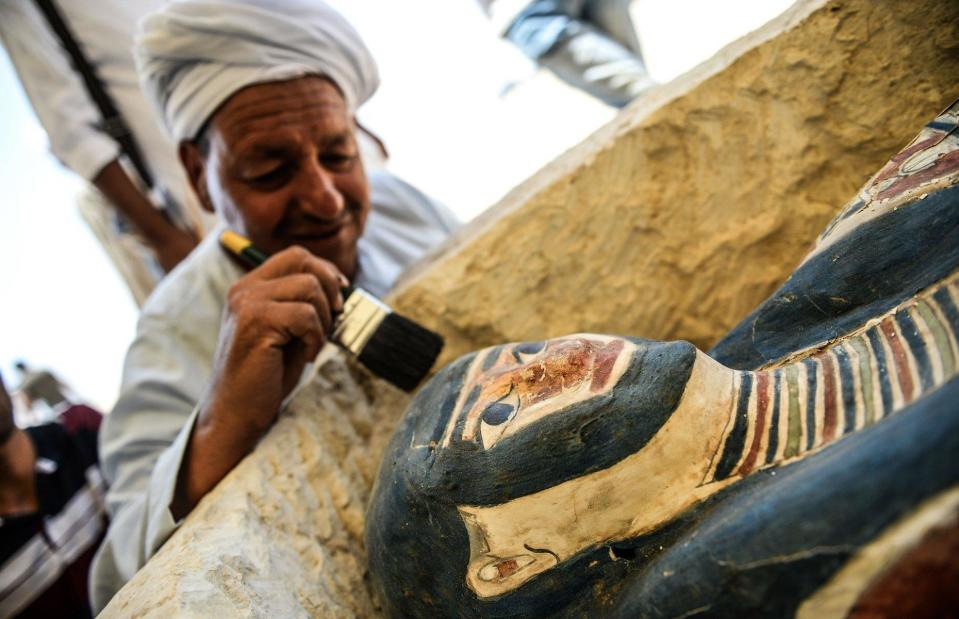
MOHAMED EL-SHAHED/AFP via Getty Images
When it comes to ancient Egypt, archaeologists never know what they might find – and when the Grand Egyptian Museum finally opens in late-spring 2024 (fingers crossed), visitors are bound to be dazzled by the displays. In recent years, a trove of ancient finds have been unearthed at key sites, including secret pyramid chambers, golden-tongued mummies and, curiously, a Buddha figurine.
See the most astonishing ancient Egyptian discoveries uncovered in the last six years...
Mummified cats, Userkaf Pyramid, Saqqara
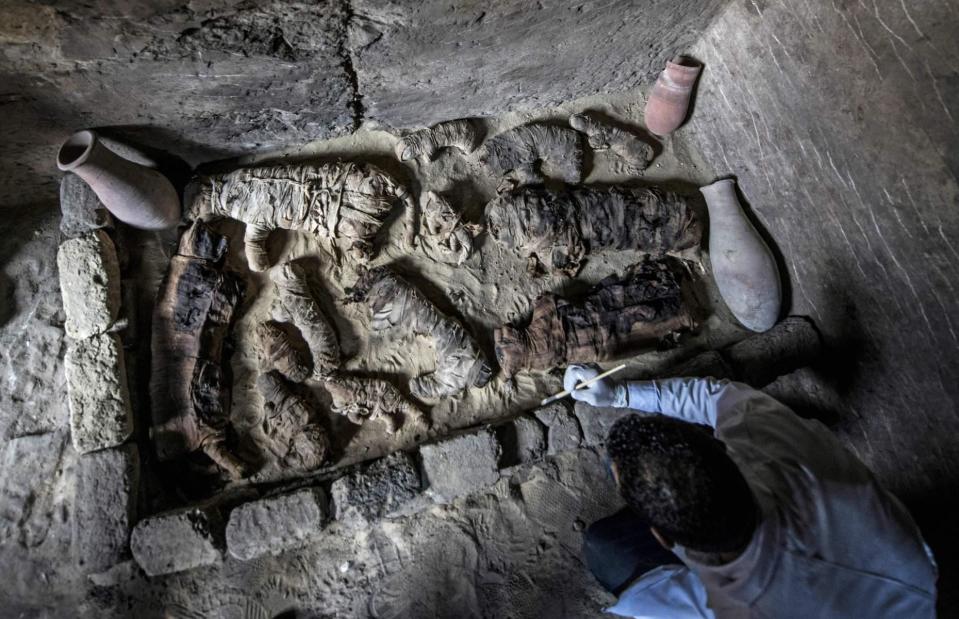
KHALED DESOUKI/AFP via Getty Images
In November 2018, archaeologists discovered a number of mummified cats in three sarcophagi (coffins) on the edge of the Userkaf Pyramid complex in Saqqara. One tomb also featured a large bronze statue of a cat dedicated to a goddess. Mummified animals served as religious offerings and cats were most common, as the ancient Egyptians believed they held special positions in the afterlife. The team also found mummified scarab beetles, believed to symbolise the sun god, Ra.
Mummies, Bent Pyramid, Dahshur
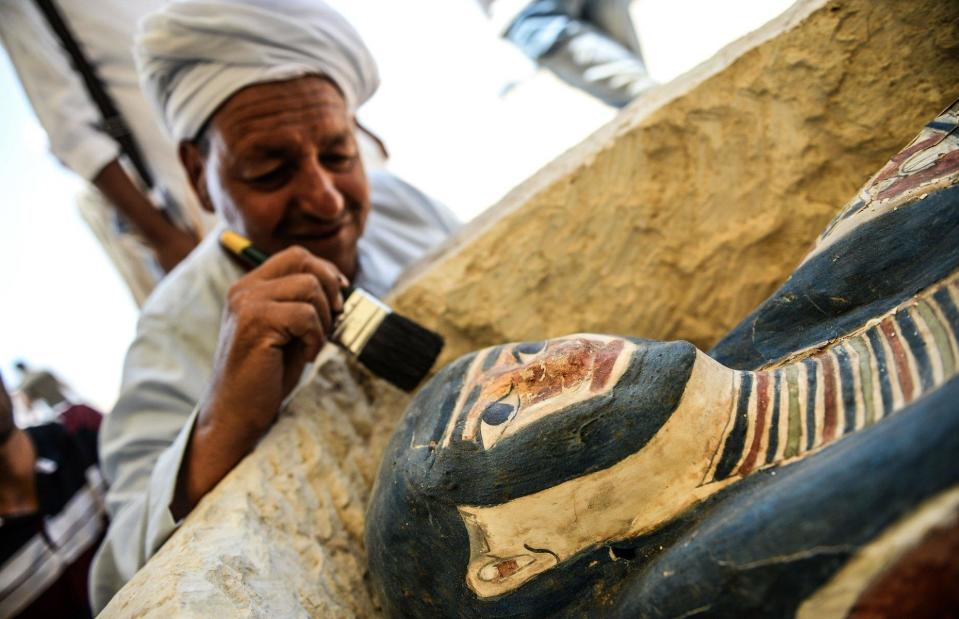
MOHAMED EL-SHAHED/AFP via Getty Images
In July 2019 a number of well-preserved mummies were discovered in and around Dahshur's Bent Pyramid area, a complex built for pharaoh Sneferu who reigned in the 25th century BC. The mummies had been laid to rest inside stone, clay and wooden sarcophagi and date to the Late Period (664-332 BC). Funerary masks were also found. The Late Period is widely considered one of the last eras of true Egyptian rule before the Persians invaded around 525 BC.
Ancient wood fragments, Khufu Pyramid, Giza
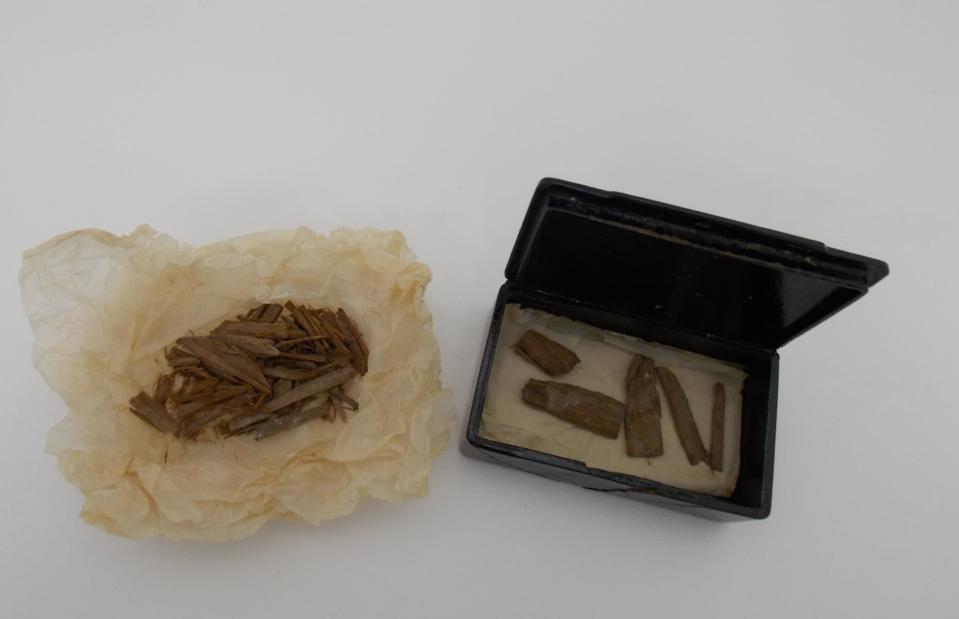
University of Aberdeen
These fragments of a small, wooden slat (possibly remnants of a measuring rule used during construction of the Khufu Pyramid, otherwise known as the Great Pyramid of Giza) were first discovered at the landmark in 1872 by Waynman Dixon. They formed one of the 'Dixon Relics' trio, which also included a copper hook and small ball of dolerite. The pictured item went missing for over a century, until a curatorial assistant at the University of Aberdeen located it in a cigar tin in 2019. Carbon analysis dated the unassuming item to 500 years before the Khufu Pyramid was built, leading experts to reconsider when the mighty wonder was actually constructed.
Wooden coffins, Saqqara
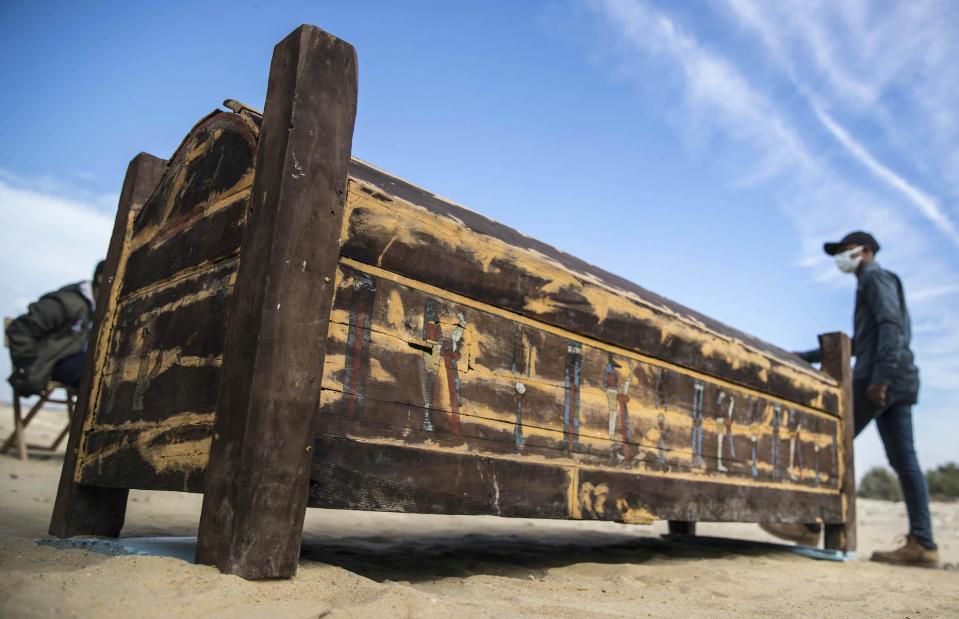
Khaled Desouki/AFP/Getty Images
Following the discovery of 100 intact sarcophagi in November 2020, archaeologists digging at the Saqqara site made another startling find in January 2021. A further 50 ornately painted wooden coffins were unearthed, once part of the burial grounds at Memphis, the ancient capital. In addition the team, headed by noted Egyptologist Zahi Hawass, found burial shafts, mummies and artefacts like amulets, funeral statues and masks. They also located the funerary temple of Queen Naert – the wife of King Teti – and a brick warehouse. The finds are over 3,000 years old, dating to the New Kingdom period (16th-11th century BC).
Historic graffiti, Bent Pyramid, Dahshur
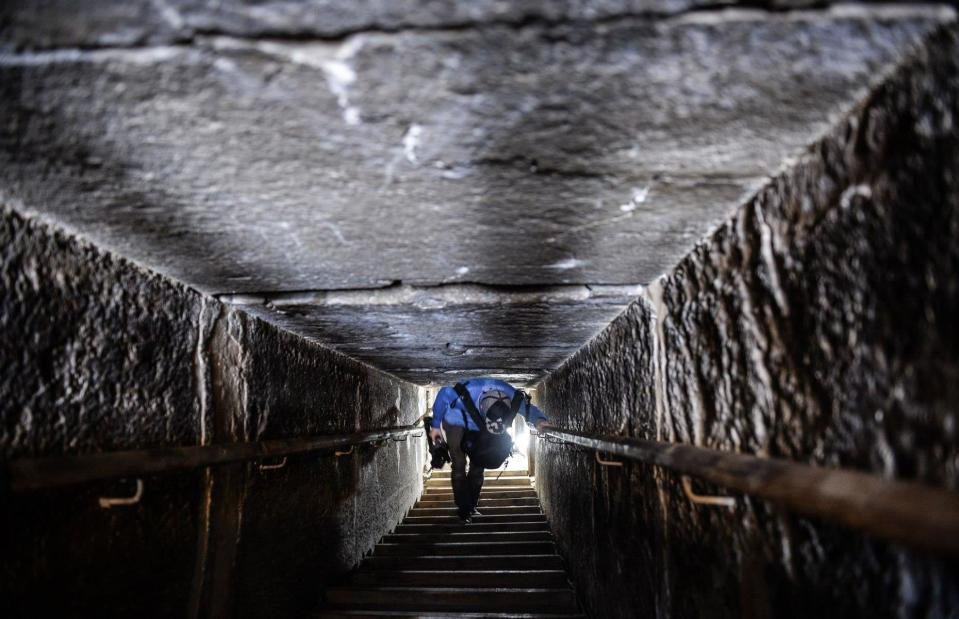
MOHAMED EL-SHAHED AFP via Getty Images
It's not technically an ancient discovery, but this YouTube video captures graffiti left by John Shae Perring, an Egyptologist who explored the Bent Pyramid in September 1839 (the date recorded in the graffiti). The 2021 video, created by author and tour leader Anyextee, also documents a stone gate that would have been lowered across the passageway to block the entrance. Very Indiana Jones.
Golden-tongued mummies, Taposiris Magna Temple, Alexandria
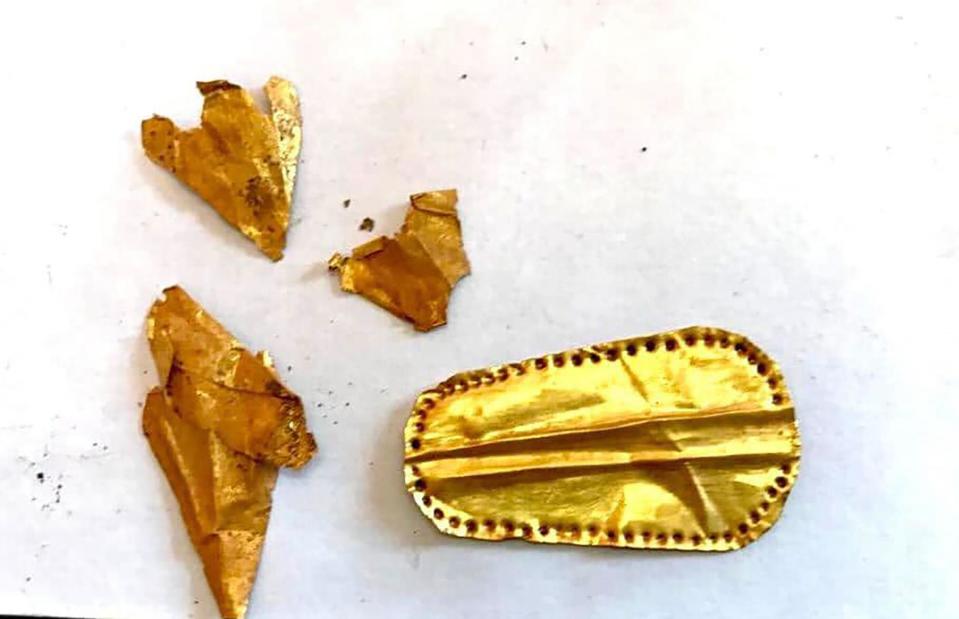
Egyptian Ministry of Tourism and Antiquities
In February 2021, archaeologists digging at a burial site at the Taposiris Magna Temple discovered 16 burial shafts dating to the Greek or Roman era, some from 2,000 years ago. What they found inside astonished them: ancient mummies with golden tongues. Amulets of gold foil, shaped to resemble tongues, were apparently placed in the mouths of the dead. It was believed that this would help them speak to the court of the god Osiris in the afterlife.
An ancient city, Luxor
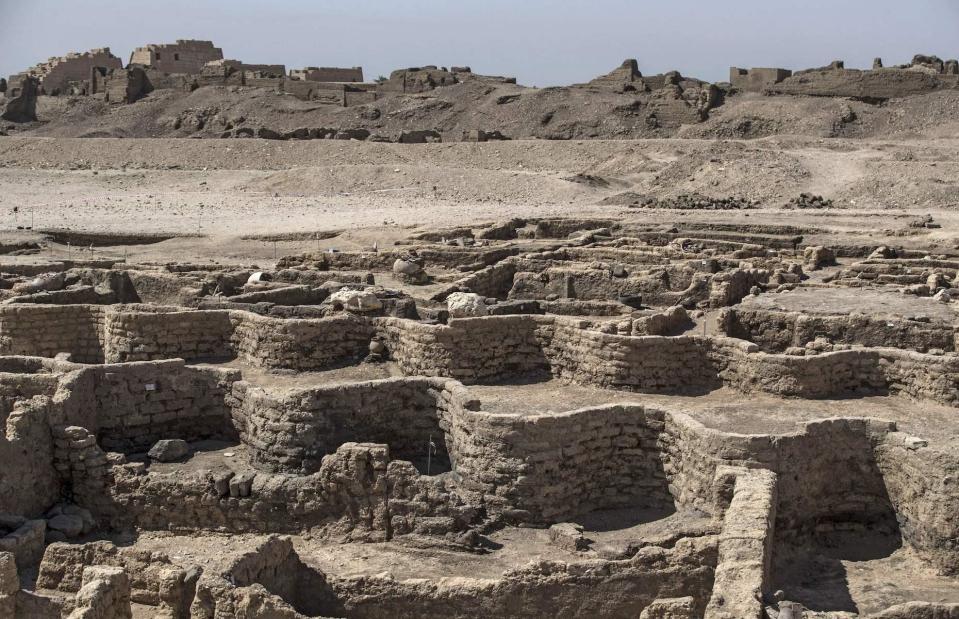
KHALED DESOUKI/AFP via Getty Images
Although excavations at the site began in September 2020, the discovery of a 3,000-year-old city known as Rise of Aten in April 2021 was hailed as the most significant archaeological find in Egypt in the past century. Egyptologist Zahi Hawass described the 'Lost Golden City', which dates to the reign of Amenhotep III, who ruled between 1391 and 1353 BC, as the largest ancient city ever found in Egypt.
Mud-brick structures, Rise of Aten, Luxor
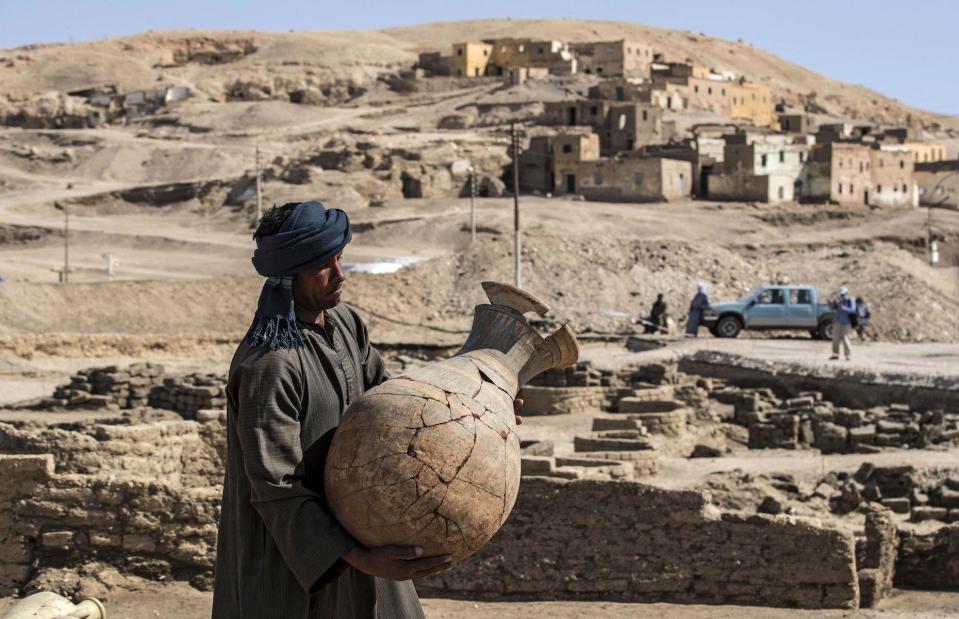
KHALED DESOUKI/AFP via Getty Images
Ongoing excavations uncovered well-preserved mud-brick structures, a bakery and various residential and industrial districts. Inside the rooms of this sprawling royal city were an abundance of important objects, including jewellery, pottery and mud bricks bearing the seals of Amenhotep III. One stand-out find was a vessel filled with what archaeologists believe was once boiled or dried meat.
Buddha statue, Temple of Isis, Berenice
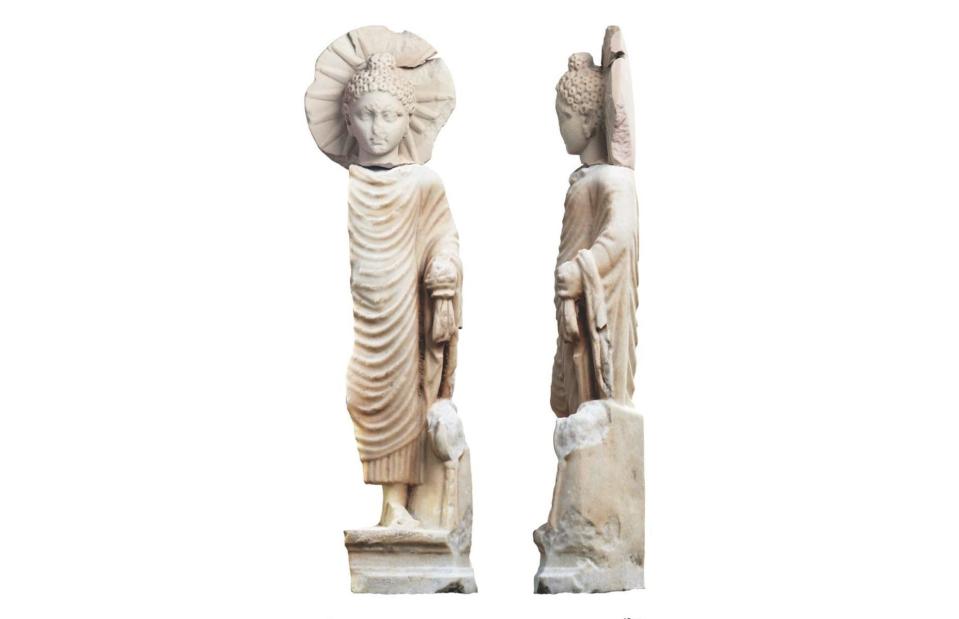
Egyptian Ministry of Tourism and Antiquities
Ancient Egyptian finds aren't all mummies and hieroglyphics. In early 2022, a team of Polish-American archaeologists discovered a marble Buddha statue inside a temple dedicated to ancient Egyptian goddess Isis. The 2,000-year-old object is 28 inches (71cm) tall and depicts Siddhartha Gautama, the father of Buddhism, stood next to a lotus flower with a halo of sunlight. Likely left by rich Indian merchants, it’s the first complete figure of the Buddha ever found in Egypt.
Crocodile heads, Theban necropolis, Luxor
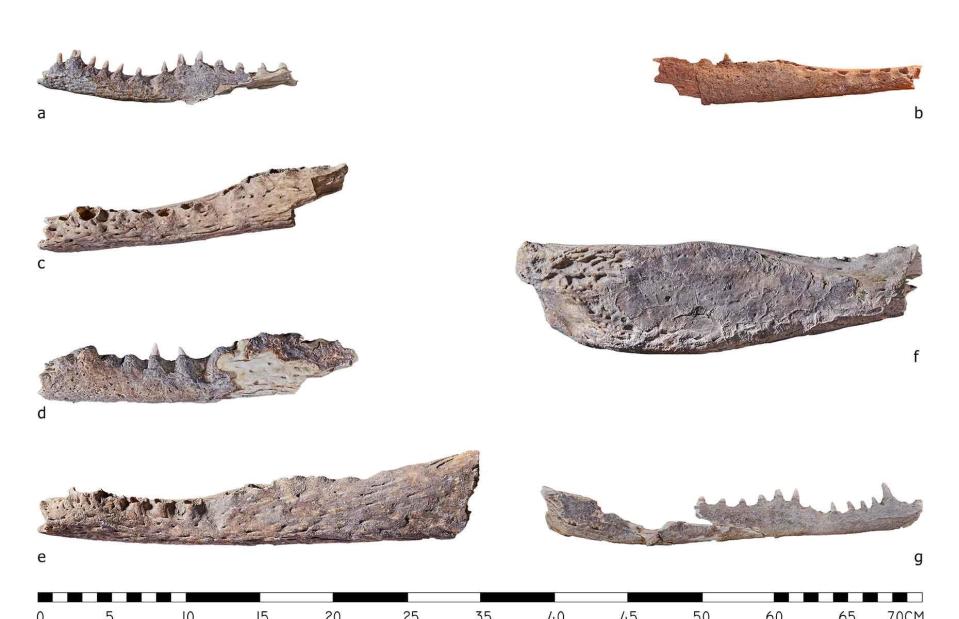
Courtesy of PCMA UW
In April 2022, a team of Polish archaeologists studying two tombs in the Theban necropolis in Luxor discovered nine crocodile heads in each tomb, wrapped in fabric. It's a very unusual find, as the reptiles' heads were only wrapped in linen; they weren't mummified or treated with any preservation techniques. Because of this, only skull and jawbone fragments have survived. Ancient Egyptians worshipped crocodiles in the form of the god Sobek, who was associated with pharaonic power, military prowess and fertility.
Pyramid of Neith, Saqqara
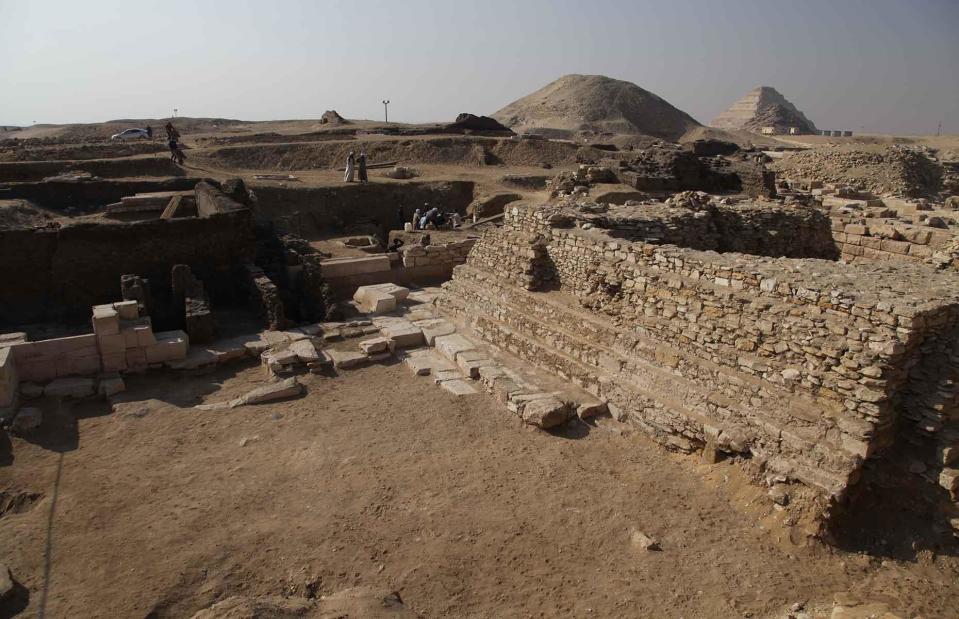
Dr Zahi Hawass
In November 2022, archaeologists located the pyramid of a previously unknown ancient Egyptian queen named Neith. We don't know much about her, but she was likely named after the ancient Egyptian goddess of creation, wisdom, weaving and war. Pictured here is the excavated site; you can see the Teti and Djoser pyramids in the background.
Coffins and mummies, Teti Pyramid, Saqqara
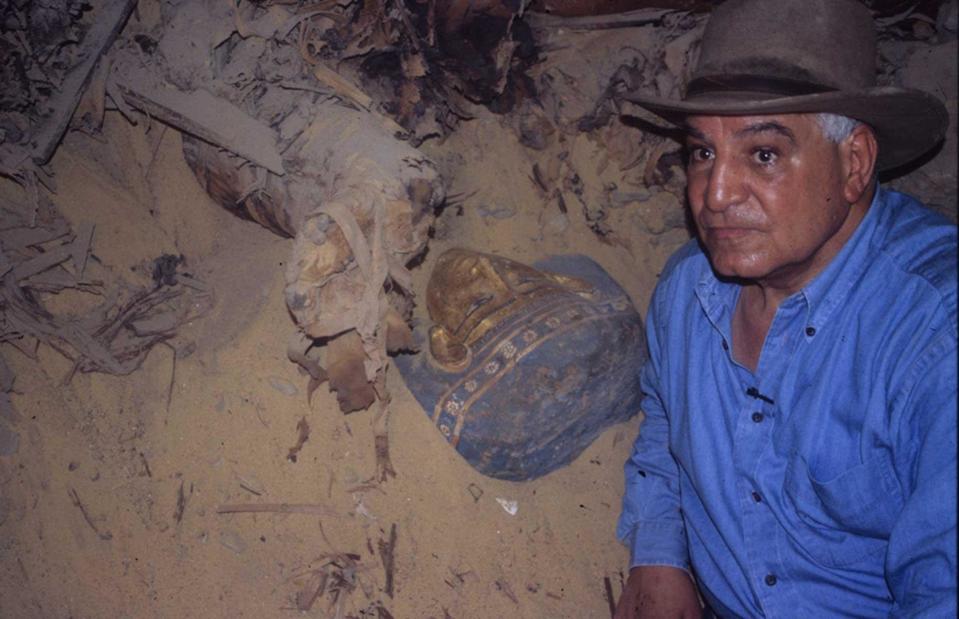
Dr Zahi Hawass
In November 2022, hundreds of coffins and well-preserved mummies dating to the New Kingdom (roughly 1539-1075 BC) were discovered by archaeologists at the Teti Pyramid. They were found in a series of interconnected tunnels, and it’s thought some of the artefacts once belonged to Tutankhamun’s closest generals and advisors. Other relics found included statues of the god Ptah-Sokar, shabtis (mummy-styled figurines), a metal axe and pieces of an ancient Egyptian game. A selection of the finds are expected to go on display at the hotly anticipated Grand Egyptian Museum when it finally opens in late-spring 2024.
Mummy of Hekashepes, Saqqara
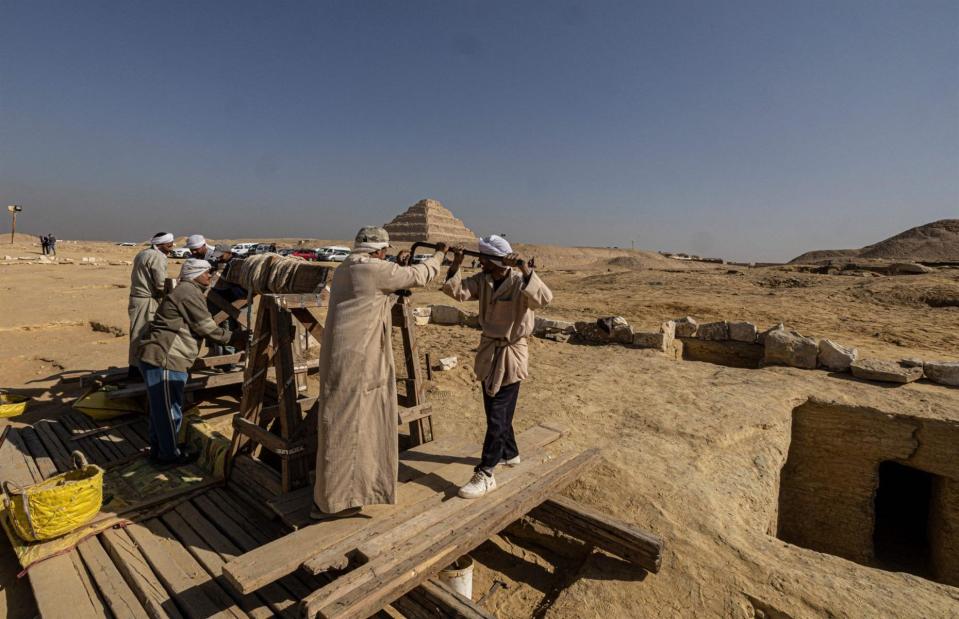
KHALED DESOUKI/AFP via Getty Images
In January 2023, archaeologists wowed the world with the discovery of a gold leaf-covered mummy. It was sealed in a sarcophagus that hadn’t been opened for 4,300 years – a rare feat considering the quantity of tomb-raiding over the centuries. The mummy belonged to a man called Hekashepes and it’s thought to be the oldest and most complete non-royal corpse ever found in Egypt. It was discovered down a 50-foot (15m) shaft at a burial site in Saqqara, and the tomb was decorated with murals, hieroglyphics and scenes of daily life from the 25th to 22nd centuries BC.
Mummy of Khnumdjedef, Saqqara
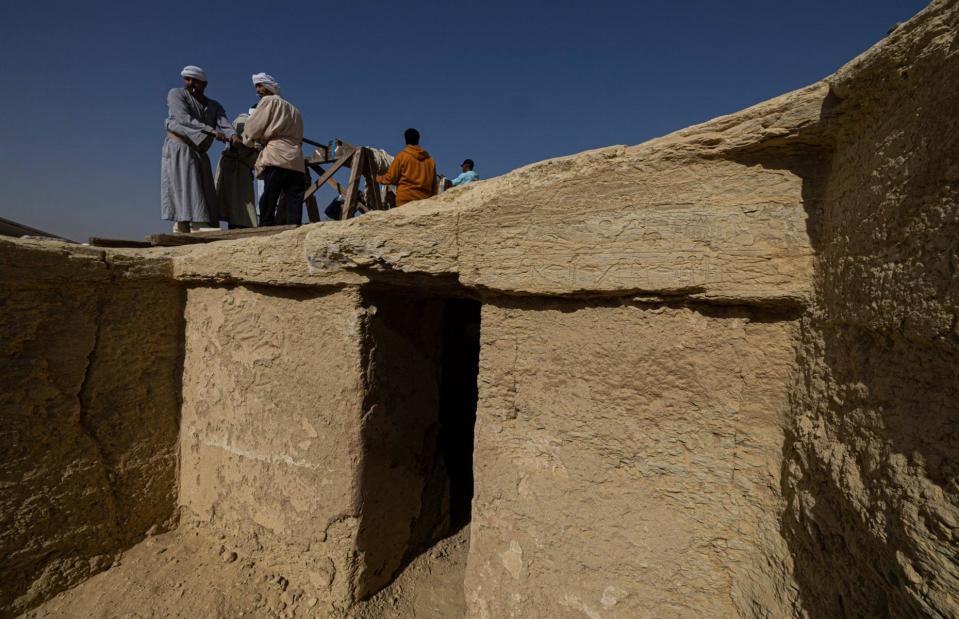
KHALED DESOUKI/AFP via Getty Images
The team found another mummy which possibly belonged to Khnumdjedef, a priest, inspector and supervisor of nobles. His tomb is the largest found at the ancient necropolis. A third mummy was also found, belonging to a man called Meri. Meri was a senior palace official called the 'secret keeper', who performed special religious rituals.
Mummy of Fetek, Saqqara
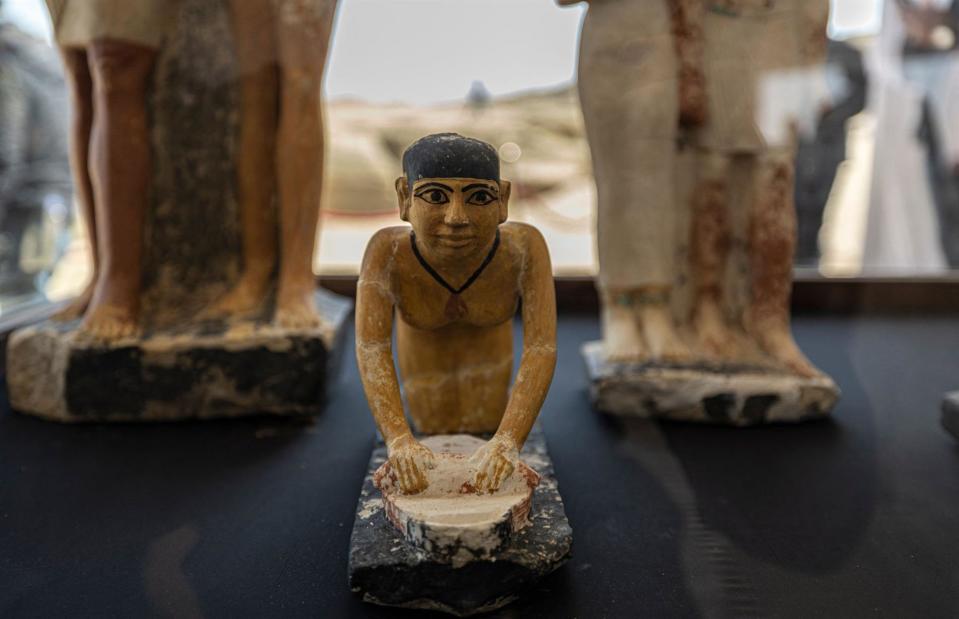
KHALED DESOUKI/AFP via Getty Images
In another tomb, where the area’s largest statues ever found were discovered, laid the mummy of Fetek, an ancient Egyptian judge and writer. Also discovered at the site were pottery and other ceremonial items, such as the detailed figurine pictured here. The finds have been dated to the 25th to 22nd centuries BC.
The Book of the Dead scroll, Saqqara
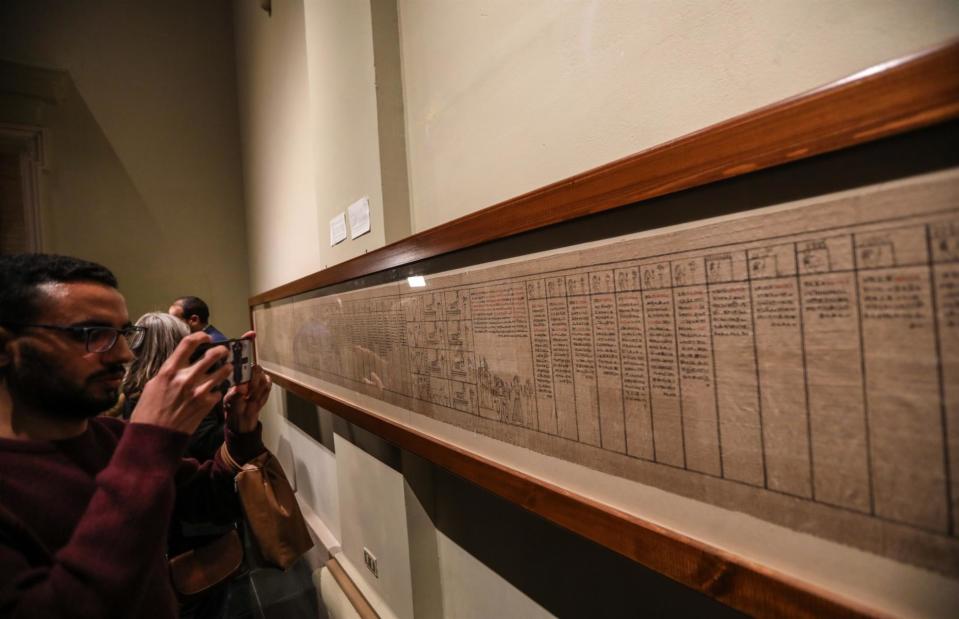
Fadel Dawod/Getty Images
In February 2023, a whopping 52-foot-long (16m) papyrus scroll was discovered by archaeologists, near the Djoser Pyramid in Saqqara. The lengthy document contained Book of the Dead chants (or 'utterances'), which were ancient Egyptian texts copied down and placed in ancient tombs. The scroll was found inside a sarcophagus belonging to Ahmose, whose name is mentioned 260 times in the document. The scroll has been restored and is now on display at the Egyptian Museum in Cairo (pictured).
Mummified ram heads, Temple of Ramesses II, Abydos
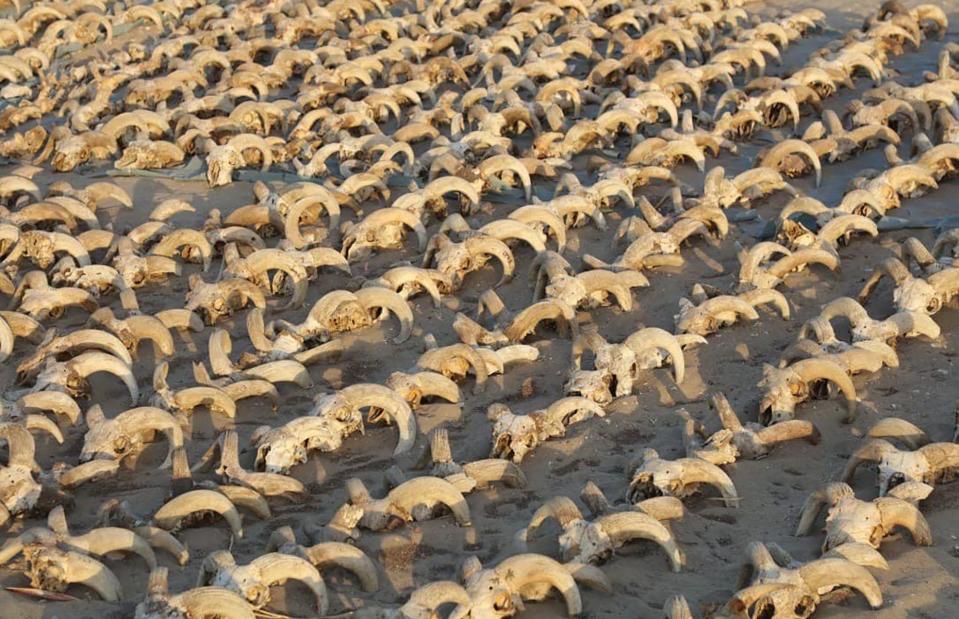
Egyptian Ministry of Tourism and Antiquities
In March 2023, archaeologists from New York University uncovered some 2,000 mummified ram heads in the Temple of Ramesses II, located in the ancient city of Abydos in southern Egypt. The team also unearthed statues, papyruses, leather clothing items and stone walls of a large palace dating back over 4,000 years.
Mummified ram heads, Temple of Ramesses II, Abydos
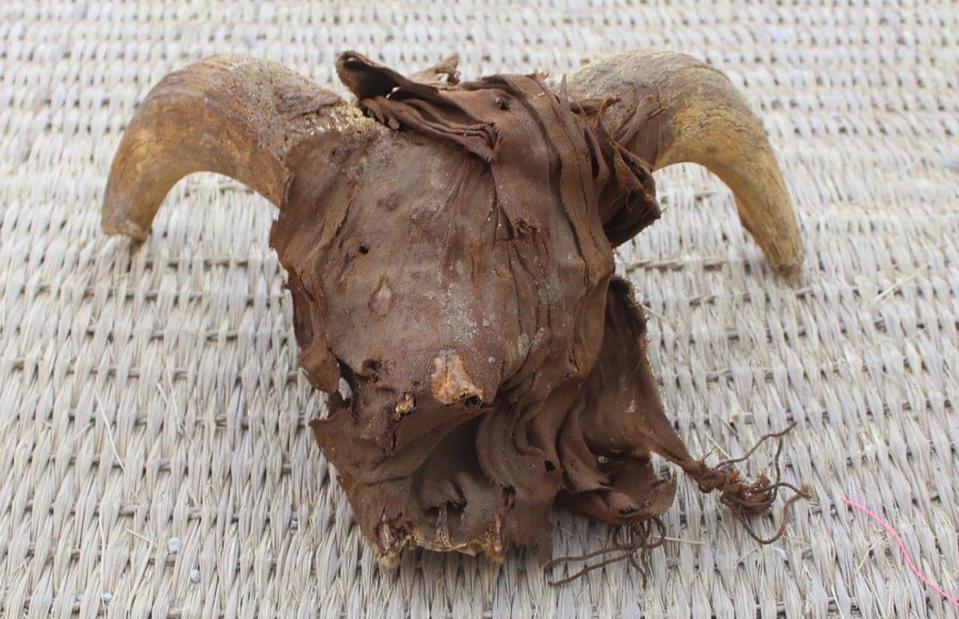
Egyptian Ministry of Tourism and Antiquities
The animals were probably offered to the legendary pharaoh Ramesses II, whose enormously long reign lasted from 1279 to 1213 BC. While the rams' flesh has disappeared, the horns are still in good condition, and mummified dogs, goats, cows, gazelles and mongooses were found alongside them. Animals were mummified the same way as humans: their organs were removed before the body (or body parts) were embalmed and bandaged.
Undisturbed tunnel, Khufu Pyramid, Giza
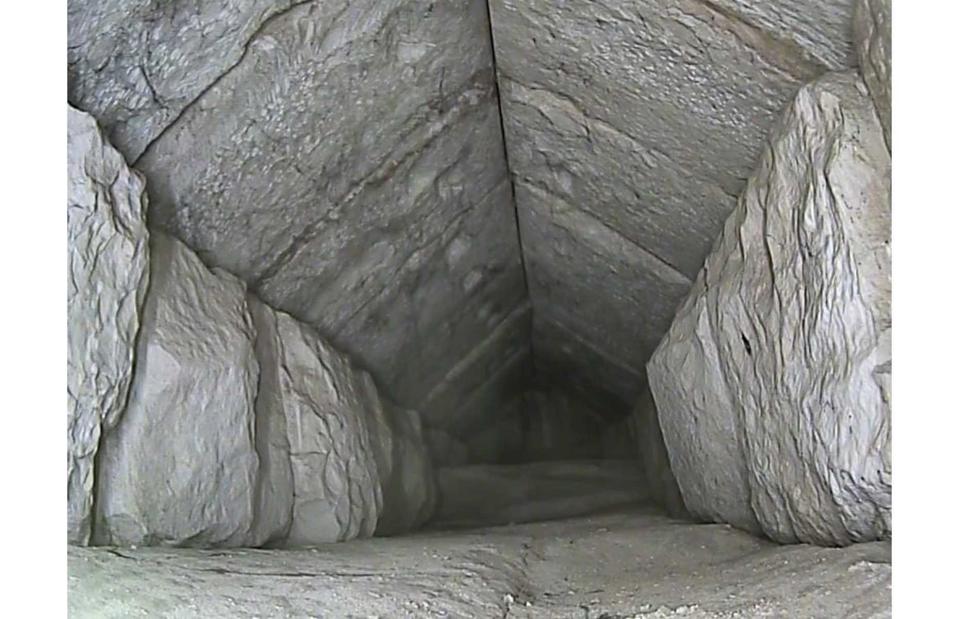
Egyptian Ministry of Tourism and Antiquities
Using high-tech ultrasound scanning equipment, this undisturbed tunnel was located in the Khufu Pyramid’s interior in March 2023 – but nobody knows where it goes or why it was built. Positioned above the northern side of the pyramid’s main entrance, the tunnel is 30 feet (9m) long and at least six feet (1.8m) wide. This image, taken using a tiny endoscope camera, shows an end chamber with two rough limestones, but it can't be entered from the outside. Was it built simply to redistribute weight around the structure, or could it have a more secret purpose?
Ceiling paintings, Temple of Esna, Esna
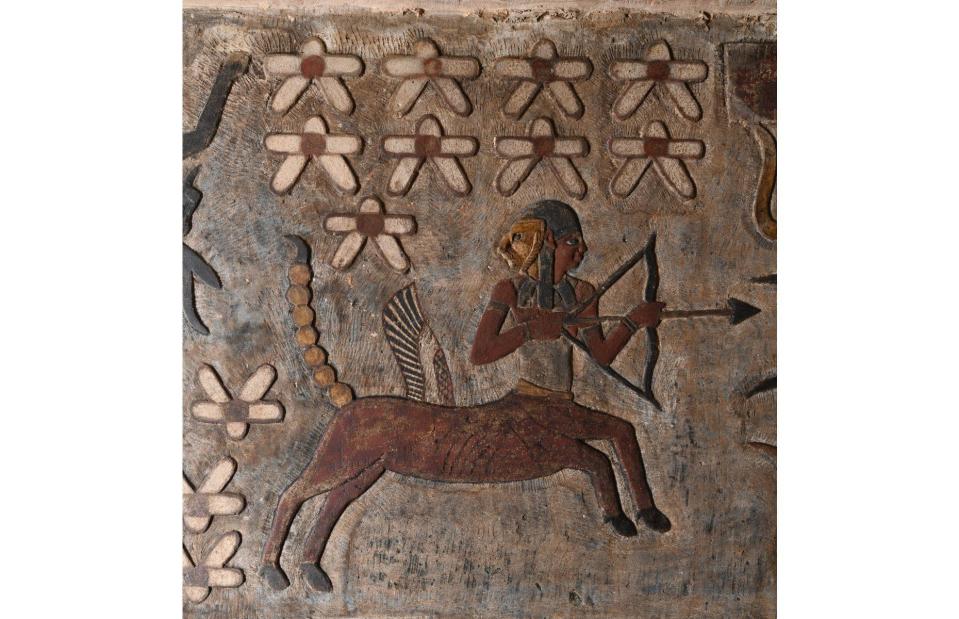
Ahmed Emam, Egyptian Ministry of Tourism and Antiquities
In early 2023, an Egyptian-German research team discovered unique ceiling paintings in the Temple of Esna (or Temple of Khnum), located on the west bank of the Nile. The paintings depict the zodiac signs like Sagittarius (pictured), and were completed during Egypt’s Ptolemaic and Roman eras (AD 40-250). They were found covered with a thick layer of soot and dirt – which helped preserve them for some 2,000 years – and have since been restored, returning them to their original, vibrant glory.
Statues and stonework, Temple of the Sun, Heliopolis
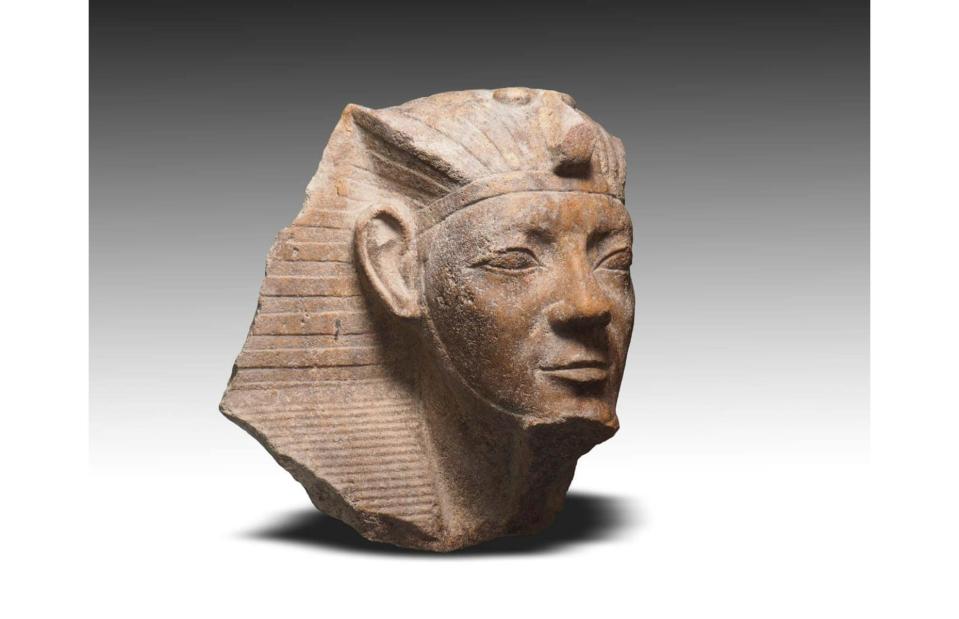
Egyptian Ministry of Tourism and Antiquities
A German-Egyptian research team digging at the Temple of the Sun in the ancient city of Heliopolis (now a suburb of Cairo) discovered a trove of interesting relics in March 2023. Stone-carved statues include a representation of the legendary pharaoh Ramesses II, alongside stonework from Horemheb, Ramesses IX and Psamtik II, who all reigned between the years of 1279 and 589 BC.
Temple of the Sun, Heliopolis
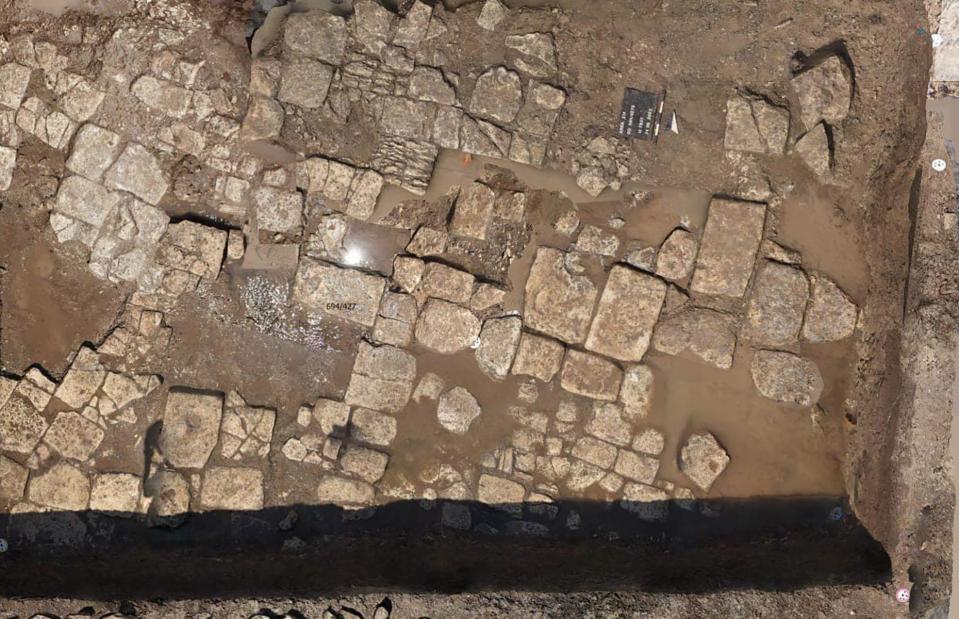
Egyptian Ministry of Tourism and Antiquities
Although the team has been digging at this site since 2012, these latest excavations have given experts plenty to talk about, as they also found traces of white ash and limestone flooring, a large inscription written in pink granite and mud-brick buildings.
Mini sphinx, Dendera temple complex, Qena
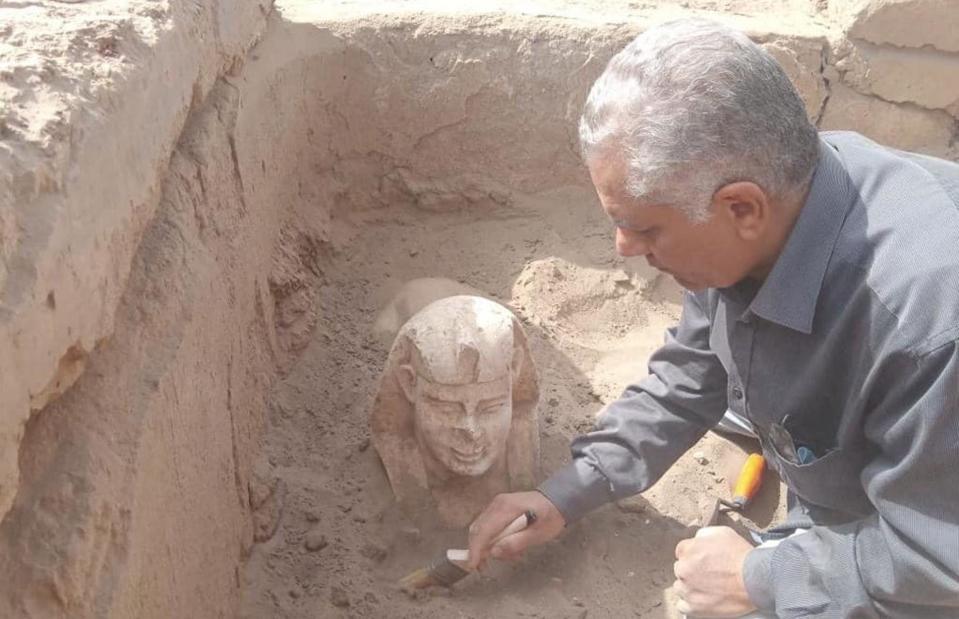
Egyptian Ministry of Antiquities/Facebook
The same team uncovered a miniature sphinx at the Dendera temple complex in Qena. Dr Mamdouh Damahi believes that the sphinx's tranquil face, slight smile and dimples show "royal features" and depict the Roman Emperor Claudius, who expanded Rome’s reach in the region in the 1st century AD. Plus, the sphinx in question (pictured) wears a nemes, a cloth headdress worn by kings. The relic was found within a limestone basin as part of a shrine dedicated to the Egyptian war god Horus, and was constructed in the Roman era (30 BC to AD 642).
Tomb of Banhesi, Saqqara
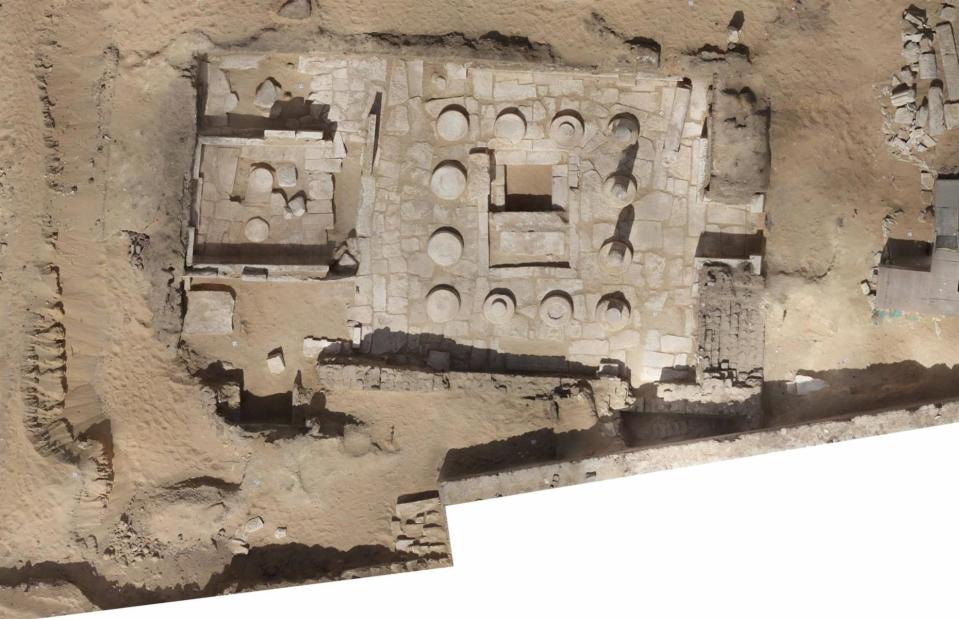
Egyptian Ministry of Tourism and Antiquities
In April 2023, a Dutch-Italian team working on an archaeological mission in Saqqara discovered a 3,000-year-old tomb, with interior panels providing clues as to who it belonged to. The structure dates to the Ramesside Period (1292-1075 BC) and was the final resting place of a man called Banhesi. One panel shows Banhesi worshipping the goddess Hathor, while another scene shows the deceased and his wife, Baya, stood next to a man wearing leopard skin over his shoulder in front of an offering table.
Tomb of Banhesi, Saqqara
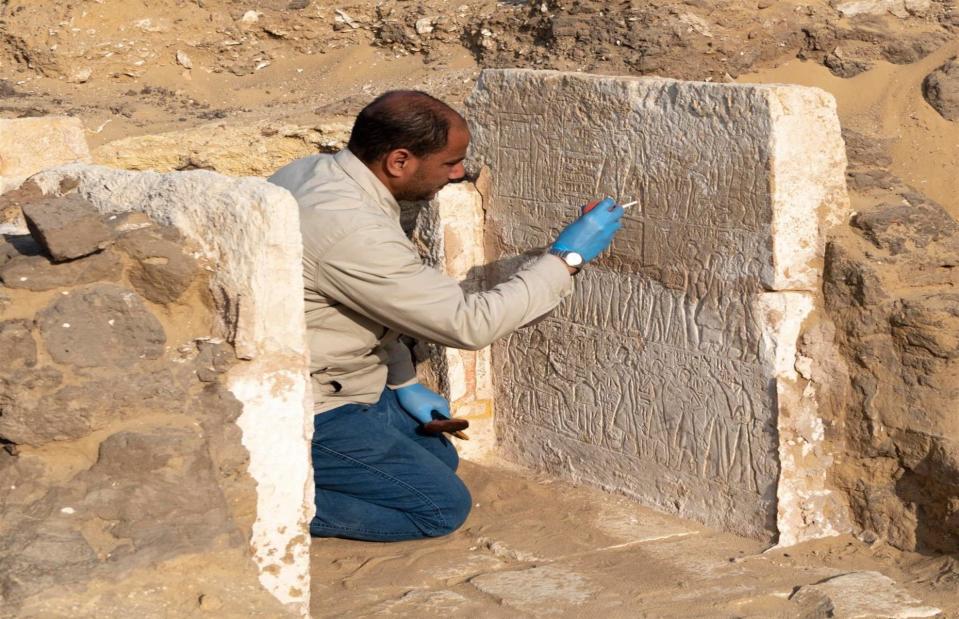
Egyptian Ministry of Tourism and Antiquities
The team also uncovered four small shrines, two of which bear inscriptions, with one belonging to a god-like person called Yoyo. The scenes depict Yoyo’s funeral procession and the mummy’s revival for the afterlife. Pictured here is an archaeologist restoring one of the limestone fragments.
Various relics, Meir archaeological site, Qusiya
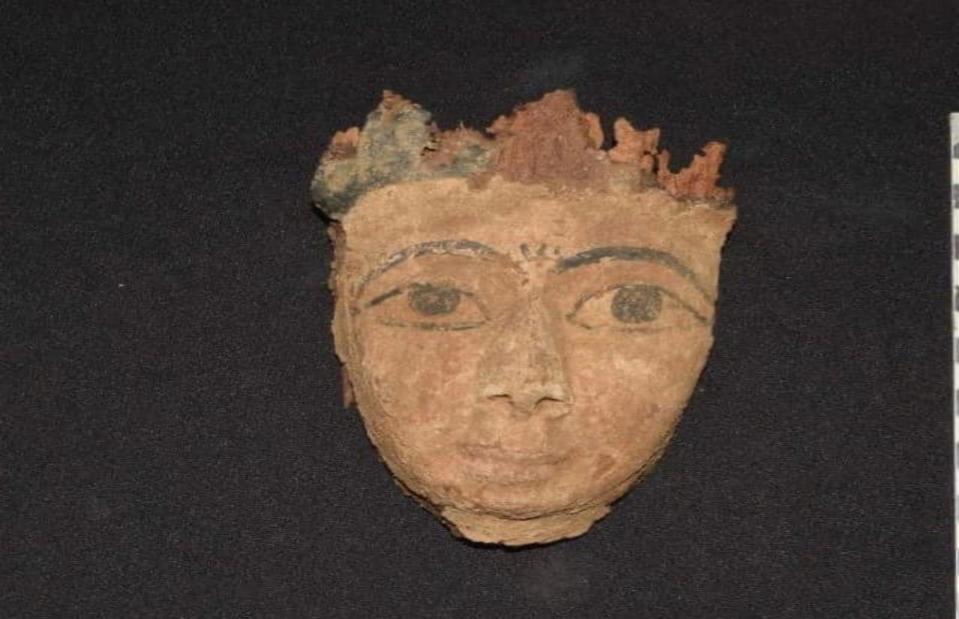
Egyptian Ministry of Tourism and Antiquities
Skeletal remains, funerary goods (like the mask pictured) and inscriptions were revealed at the Meir archaeological site in Qusiya in May 2023. In ancient times Qusiya was known as Cusae, and Meir served as a cemetery for nomarchs, mayors and city priests during the Old and Middle Kingdom periods (2300-1800 BC). The rock-hewn tombs also yielded jewellery, pottery and copper mirrors.
Various relics, Meir archaeological site, Qusiya
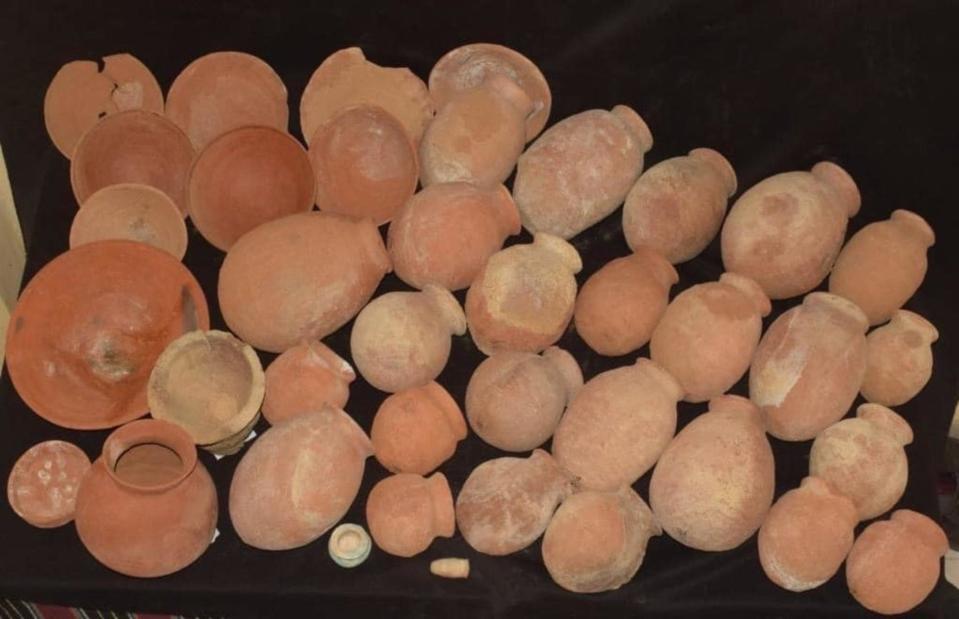
Egyptian Ministry of Tourism and Antiquities
Cusae was a cult centre for Hathor, an ancient Egyptian goddess, and in the new tomb the team “uncovered prayers and supplications of the saints” which were inscribed in black pencil on the walls, arranged in eight lines of Coptic script (an Egyptian language using Greek letters). Provisions and sacred manuscripts were probably stored on clay and straw shelves that were also discovered.
Various relics, Meir archaeological site, Qusiya
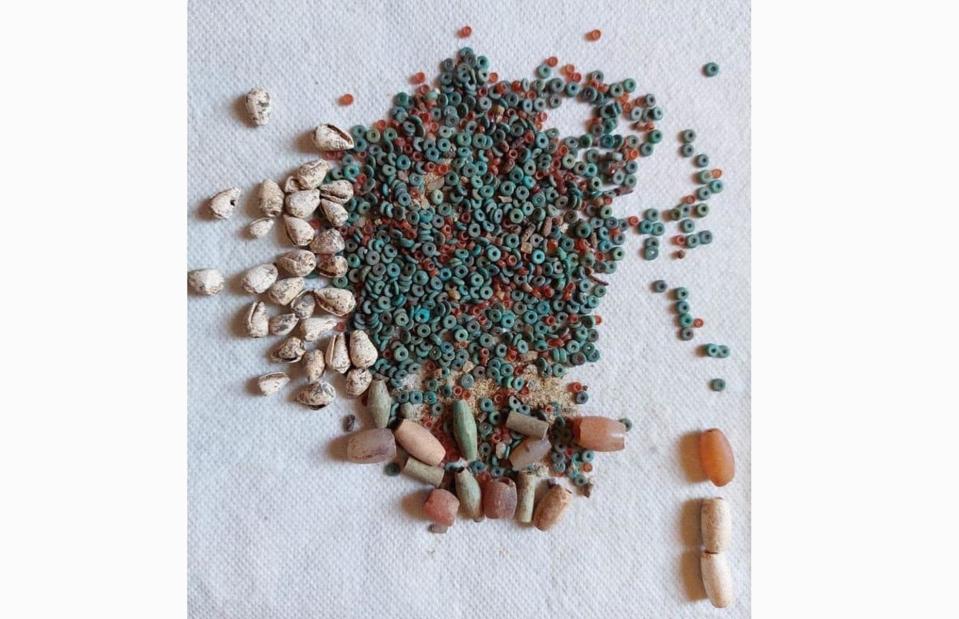
Egyptian Ministry of Tourism and Antiquities
The building, in the upper region of the site, also featured a patio, multiple rooms, storage areas and a fireplace, as well as personal items like blue and black engagement beads (pictured).
Ancient figurines, Kluczkowice, Poland
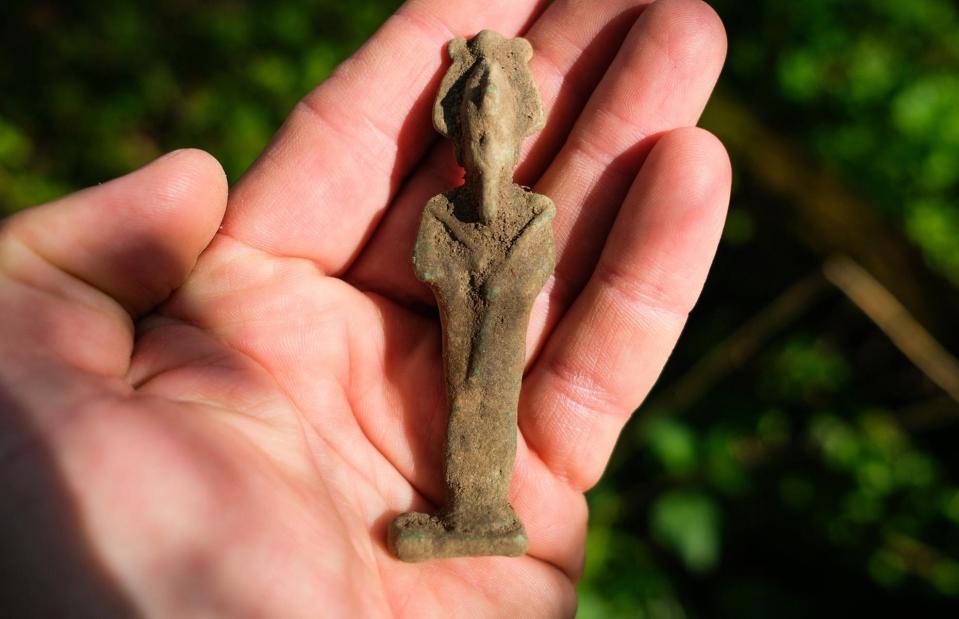
Dr. Lukasz Miechowicz
We're guessing most Egyptologists had never heard of Kluczkowice, but the discovery of several ancient Egyptian figurines there in May 2023 thrust the Polish town unexpectedly into the spotlight. The statues were found during unrelated excavations and depict Osiris, Egyptian god of the dead and the afterlife, and Bacchus, the Roman god of winemaking, fertility and fruit. The finds were so unusual that there were obvious questions around authenticity, but subsequent analysis confirmed that the statues were real. The two Osiris statues date from the first millennium BC, while the single Bacchus statue dates from the first century AD.
Ancient figurines, Kluczkowice, Poland
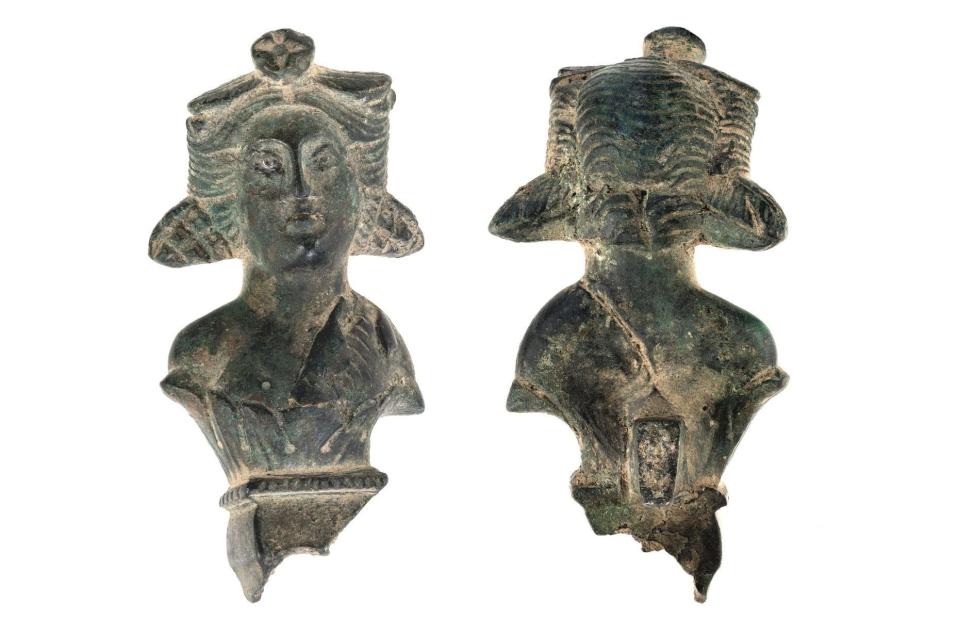
Dr. Lukasz Miechowicz
Unsurprisingly, they did not enter Poland during the ancient Egyptian era. Researchers think they were owned by the Kleniewski family, who lived in the Palace of Kluczkowice and owned an impressive collection of antiquities, until Nazi Germany invaded in 1939. According to the diaries of Maria Kleniewska, she and her family visited Egypt for several months in 1904, giving them ample time to acquire the figurines. The family may then have then hidden the relics during the war, or shortly after when the palace was being looted.
Mummified bodies of high priests, Minya
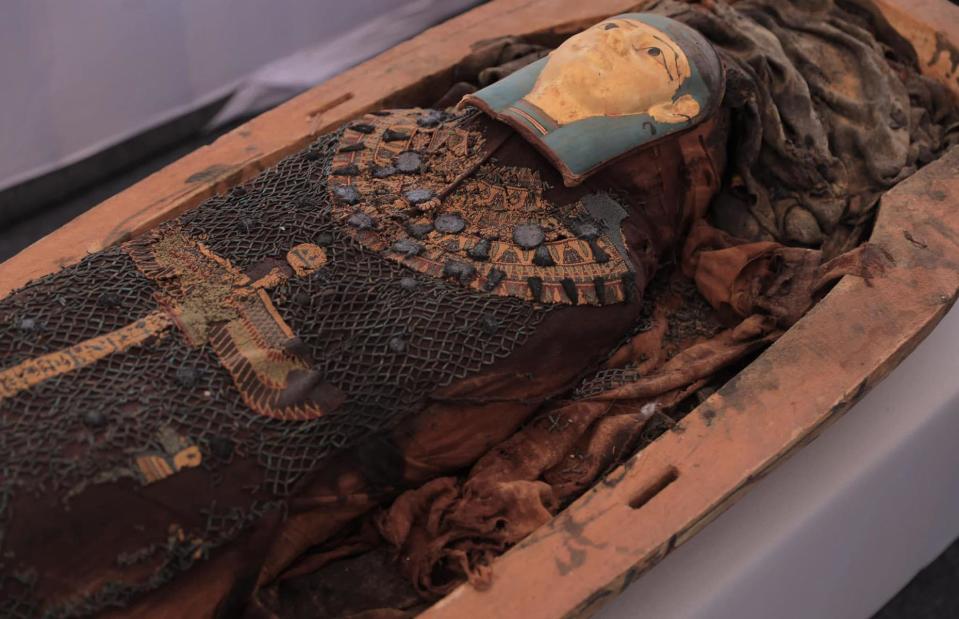
Egyptian Ministry of Tourism and Antiquities
Ancient stone and wooden coffins containing 3,400-year-old mummified bodies of high priests and officials were unearthed in late 2023. The New Kingdom cemetery, in the Al-Ghuraifa area of the Tuna El-Gebel necropolis in Minya, also included coffins inscribed with the names of two women, as well as hundreds of amulets and ornaments, Ushabti statues made of pottery and wood, and a complete papyrus featuring the Book of the Dead, the first found in the area. The papyrus will be displayed at the Grand Egyptian Museum in Giza.
Unopened wine in female 'king' tomb, Abydos
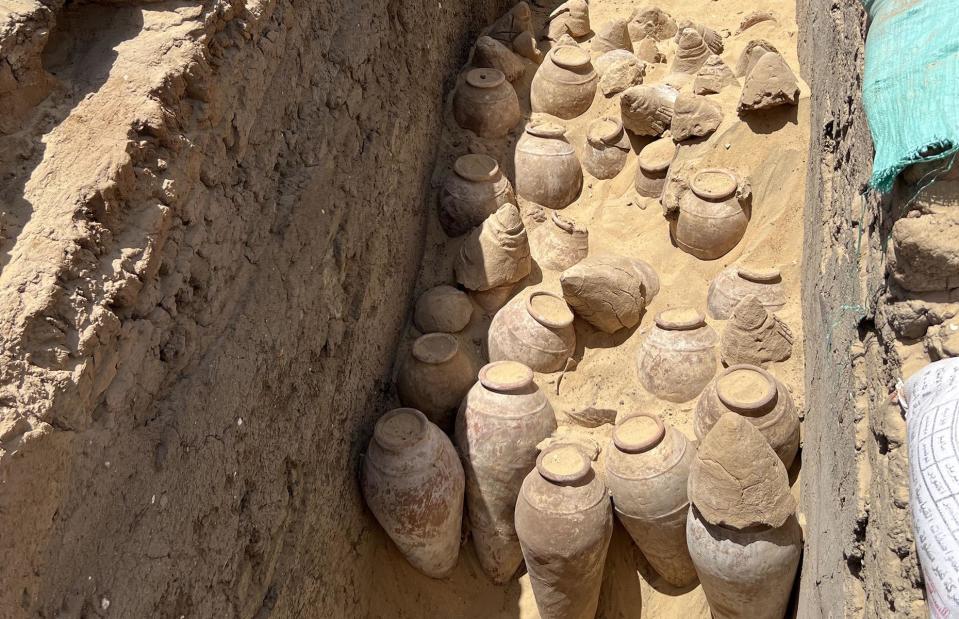
EC Kohler/University of Vienna
An astonishing collection of 5,000-year-old unopened wine jars and other grave goods was found in the tomb of Queen Meret-Neith in October 2023. Archaeologists who excavated the site in Abydos, central Egypt, believe the artefacts suggest that Meret-Neith held a position of high power and have dubbed her a female 'king'. "She was probably the most powerful woman of her time, and today’s researchers speculate that Meret-Neith may have been the first female pharaoh in ancient Egypt," says a statement from the team of archaeologists, led by Christiana Kohler from the University of Vienna.
Tomb with snake inscriptions, Abusir
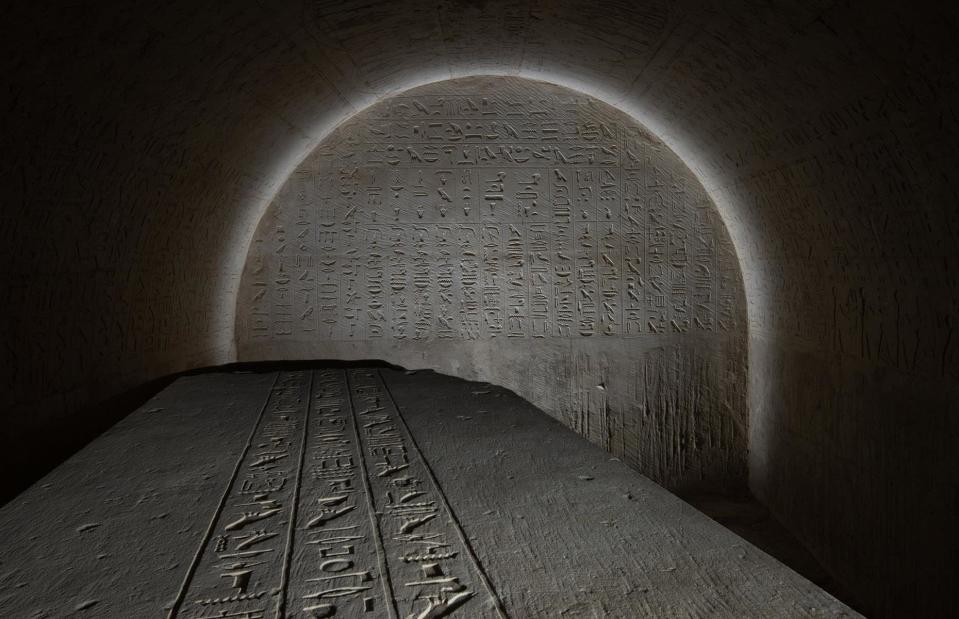
Petr Kosarek/Czech Institute of Egyptology/Univerzita Karlova
In spring 2023, archaeologists from the Czech Institute of Egyptology came across a brand-new tomb occupied by a royal scribe named Dzehutiemhat, at the Abusir site south of Cairo. The man lived around 2,500 years ago at a time when Egypt was under Persian control, and his skeleton showed signs of the bone disease osteoporosis – probably an inherited condition as he died aged 25. Unusual inscriptions were carved around the tomb's entrance – spells intended to ward off snake bites, and recruit snakes as the tomb's protectors.
Now discover the fascinating stories behind the Pyramids of Giza

